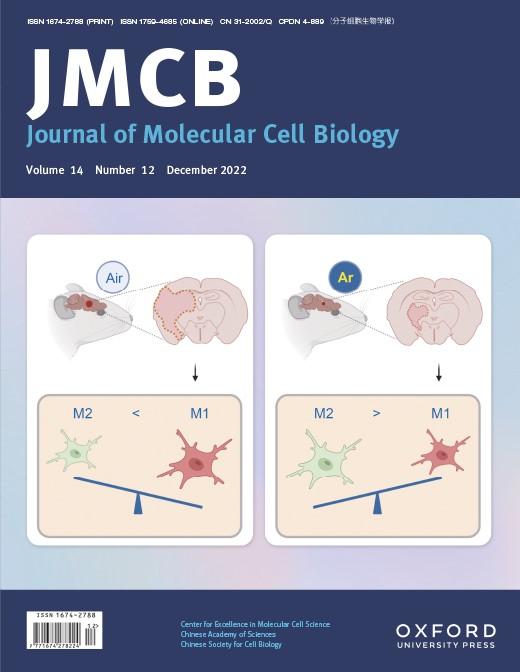scRNA-seq profiling of neonatal and adult thymus-derived CD4+ T cells by a T cell origin-time tracing model
Yuheng Han, Xinxing Ouyang, Yao Chen, Shujing Lai, Hongxiang Sun, Ningbo Wu, Chun Ruan, Limin Lu, Bing SuJ Mol Cell Biol, Volume 14, Issue 12, December 2022, mjac072, https://doi.org/10.1093/jmcb/mjac072Abstract | Full Text |
Histone lactylation driven by mROS-mediated glycolytic shift promotes hypoxic pulmonary hypertension
Jian Chen, Meiling Zhang, Yanjie Liu, Shihong Zhao, Yanxia Wang, Meng Wang, Wen Niu, Faguang Jin, Zhichao LiJ Mol Cell Biol, Volume 14, Issue 12, December 2022, mjac073, https://doi.org/10.1093/jmcb/mjac073Abstract | Full Text |
Argon mitigates post-stroke neuroinflammation by regulating M1/M2 polarization and inhibiting NF-κB/NLRP3 inflammasome signaling
Ke Xue, Mian Qi, Tongping She, Zhenglin Jiang, Yunfeng Zhang, Xueting Wang, Guohua Wang, Lihua Xu, Bin Peng, Jiayi Liu, Xinjian Song, Yuan Yuan, Xia LiJ Mol Cell Biol, Volume 14, Issue 12, December 2022, mjac077, https://doi.org/10.1093/jmcb/mjac077Abstract | Full Text |
Circadian clock control of MRTF/SRF pathway suppresses beige adipocyte thermogenic recruitment
Xuekai Xiong, Weini Li, Ruya Liu, Pradip Saha, Vijay Yechoor, Ke MaJ Mol Cell Biol, Volume 14, Issue 12, December 2022, mjac079, https://doi.org/10.1093/jmcb/mjac079Abstract | Full Text |
GoldenFish: a rapid and efficient system to customize constructs for zebrafish transgenesis
Zhanmei Jiang, Lirong Huang, Jieqiong Zhao, Yanfeng Li, Jianlong Ma, Rui Ni, Qifen Yang, Lingfei Luo, Yun Yang, Jingying ChenJ Mol Cell Biol, Volume 14, Issue 12, December 2022, mjac075, https://doi.org/10.1093/jmcb/mjac075Abstract | Full Text |
Targeted mutagenesis in rabbit using an engineered BhCas12b variant
Yingqi Jia, Tian Wang, Ding Zhao, Zhiquan Liu, Tingting Sui, Siyu Chen, Jinze Li, Liangxue Lai, Zhanjun LiJ Mol Cell Biol, Volume 14, Issue 12, December 2022, mjac076, https://doi.org/10.1093/jmcb/mjac076Abstract | Full Text |
